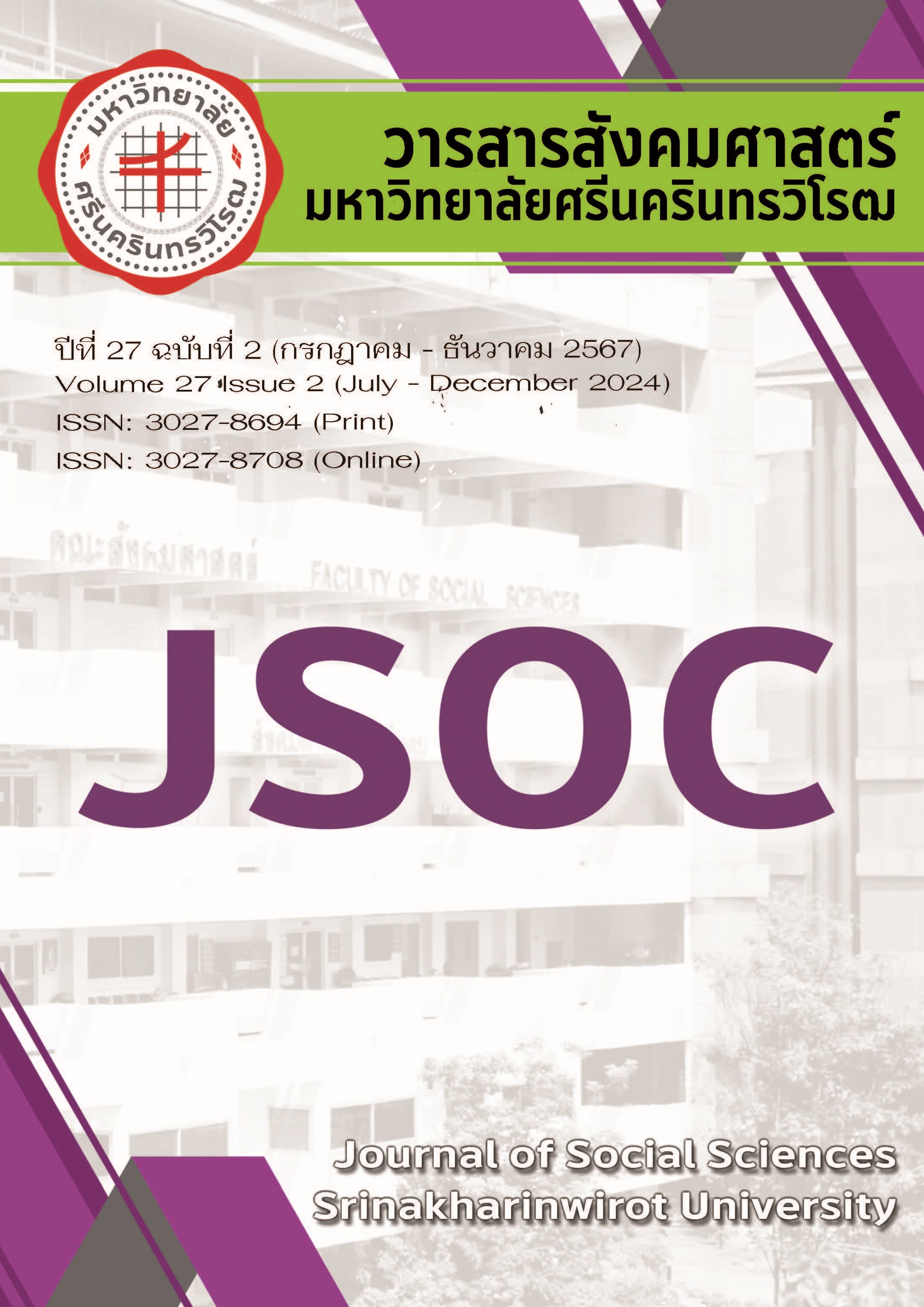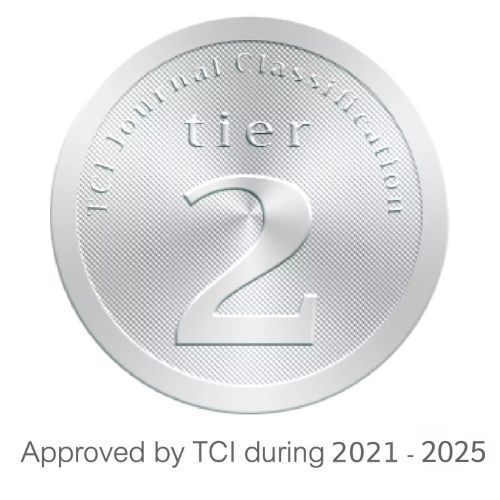การวิเคราะห์การเปลี่ยนแปลงการใช้ประโยชน์ที่ดินที่มีผลต่อการเกิดน้ำท่าในลุ่มน้ำระยอง
Analysis of Land Use Change on Runoff Generation in Rayong Watershed
Keywords:
แบบจำลอง SWAT, น้ำท่า, การเปลี่ยนแปลงการใช้ประโยชน์ที่ดิน , แบบจำลอง CA-Markov, ลุ่มน้ำระยองAbstract
งานวิจัยนี้มีวัตถุประสงค์เพื่อวิเคราะห์การเปลี่ยนแปลงการใช้ประโยชน์ที่ดินต่อปริมาณน้ำท่าในลุ่มน้ำระยอง วิธีการวิจัยเริ่มจากการใช้แบบจำลอง Soil and Water Assessment Tool (SWAT) คาดการณ์ปริมาณน้ำท่า โดยสอบเทียบค่าพารามิเตอร์และประเมินประสิทธิภาพแบบจำลองด้วยข้อมูลน้ำท่าตรวจวัดรายวันในปี 2558-2563 จากนั้นจึงคาดการณ์การใช้ประโยชน์ที่ดินในลุ่มน้ำระยองในปี 2570 2575 และ 2580 จากการเปลี่ยนแปลงระหว่างปี 2553-2559 ด้วยแบบจำลอง CA-Markov ใน 3 สถานการณ์ ประเมินความน่าเชื่อถือของการจำลองด้วยข้อมูลการใช้ประโยชน์ที่ดินปี 2563 ผลการศึกษาพบว่าสามารถคำนวณปริมาณน้ำท่าได้ในเกณฑ์พอใช้ในลุ่มน้ำดอกกราย ลุ่มน้ำหนองปลาไหล และลุ่มน้ำคลองใหญ่ โดยมีดัชนี NSE 0.37-0.57 และ R2 0.37-0.58 ในขณะที่ลุ่มน้ำทับมา ปริมาณน้ำท่าในช่วงอัตราการไหลสูงมีค่าน้อยกว่าค่าตรวจวัด และลุ่มน้ำบ้านค่ายปริมาณน้ำท่าจากแบบจำลองมีความถูกต้องน้อยที่สุด การใช้ประโยชน์ที่ดินของลุ่มน้ำระยองในปี 2580 ในสถานการณ์ที่พื้นที่อุตสาหกรรมเพิ่มขึ้นเฉลี่ยปีละ 0.5% และพื้นที่เกษตรกรรมลดลงเฉลี่ยปีละ 0.51% ของพื้นที่ลุ่มน้ำ ส่งผลให้ปริมาณน้ำท่าเพิ่มขึ้น 25.94% จากปี 2563 ซึ่งมากกว่าสถานการณ์อื่น ๆ การใช้ประโยชน์ที่ดินประเภท พืชไร่ ยางพารา อุตสาหกรรม และชุมชน ส่งผลทำให้เกิดการเปลี่ยนแปลงปริมาณน้ำท่ามากที่สุดในทุกสถานการณ์จำลอง (R2 0.89-0.99) ในระดับลุ่มน้ำย่อยพบว่า ลุ่มน้ำทับมามีปริมาณน้ำท่าเพิ่มขึ้นมากที่สุดจากปี 2563 เนื่องจากพื้นที่อุตสาหกรรมและชุมชนเพิ่มขึ้นในขณะที่พื้นที่เกษตรกรรมลดลง มี (R2 0.7-0.99) และไม่พบความสัมพันธ์ระหว่างสัดส่วนการใช้ที่ดินแต่ละประเภทกับปริมาณน้ำท่าที่ชัดเจนในลุ่มน้ำย่อยอื่น ๆ (This research investigates the impacts of land use changes on discharge in the Rayong basin. The methodology starts with using the Soil and Water Assessment Tool model (SWAT) to simulate the discharge. The model was calibrated and validated against daily discharge observations between 2558BE to 2563BE. Then, land use projection in 2570BE, 2575BE, and 2580BE was made for the Rayong basin in three scenarios using the CA-Markov model. This land use projection was based on patterns of land use changes from 2553BE to 2559BE. Land use in 2563BE was used to evaluate the reliability of the land use projection. The results show that discharge in the Rayong basin can be satisfactorily simulated with Nash-Sutcliffe Efficiency (NSE) ranging from 0.37 to 0.57 and R2 from 0.37 to 0.58 in Dok Krai, Nong Pla Lai, and Khlong Yai subbasin. However, the model underestimates the amount of discharge during high flow periods in the Tab Ma subbasin, while the accuracy of discharge simulation is lowest in the Ban Kai subbasin. Land use in 2580BE largely increases the amount of runoff generated in the Rayong basin, particularly in the scenario where the industrial area increases by 0.5% per year and the agricultural area decreases by 0.51% per year, i.e. discharge increases by 25.94% from 2563BE compared to other scenarios. Changes in cropland, rubber plantations, industrial, and residential areas contribute to remarkable increases in catchment discharge in all land use change scenarios (R2 ranging from 0.89 to 0.99). Tap Ma subbasin shows the largest increase in runoff generation compared to other subcatchments. Relations between the proportion of industrial, residential, and agricultural areas to the amount of runoff generated are very high (R2 between 0.7 and 0.99). However, these relations in other sub-basins are quite minor.)References
กรมชลประทาน. (2562). รายงานแผนแม่บทการพัฒนาลุ่มน้ำ จังหวัดระยอง. กรุงเทพมหานคร: กรมชลประทาน.
กรมพัฒนาที่ดิน. (2565). สภาพการใช้ที่ดินภาคตะวันออก. สืบค้นเมื่อ 3 กุมภาพันธ์ 2565, จาก http://www1.ldd.go.th/web_OLP/report_ research _E.html
กานดา วรรณวิเศษ. (2558). การเปลี่ยนแปลงสภาพภูมิอากาศ: ผลกระทบต่อประเทศไทย (Climate Change: Effects to Thailand). สำนักวิชาการเลขาธิการ วุฒิสภา. 5(17): 25.
ไทยรัฐออนไลน์. (2558, 18 กันยายน). ระยองน้ำทะลักเข้าเมือง ท่วมมิดเขตเทศบาล ต.ทับมา. สืบค้นเมื่อ 6 กุมภาพันธ์ 2565, จาก https://www.thairath.co.th/news/local/526201.
แนวหน้า. (2563, 22 ธันวาคม). ระยองเดินหน้าแผนพัฒนาจังหวัดดันโครงการแก้ไขปัญหาน้ำท่วมพื้นที่เศรษฐกิจ คลองทับมา. สืบค้นเมื่อ 6 กุมภาพันธ์ 2565, จาก https://www.naewna.com/local/543142
สถาบันสารสนเทศทรัพยากรน้ำและการเกษตร. (2558). บันทึกเหตุการณ์น้ำท่วมจากอิทธิพลของพายุ "หว่ามก๋อ" (VAMCO) (14-18 ก.ย. 58). สืบค้นเมื่อ 6 กุมภาพันธ์ 2565, จาก https://tiwrm.hii.or.th/current/2015/vamco/vamco_ sep57.html
สำนักงานทรัพยากรน้ำแห่งชาติ. (2564). 22 ลุ่มน้ำในประเทศไทย และพระราชกฤษฎีกา กำหนดลุ่มน้ำ พ.ศ.2564. สืบค้นเมื่อ 25 กุมภาพันธ์ 2565, จาก http://www.onwr.go.th/?p=10637
สุปรีชญา บุญมาก; พงศ์ชยนต์ ศรีสุวรรณ; และณัฐวรรณ สมรรคจันทร์. (2562). จาก Eastern Seaboard สู่ EEC การพัฒนาพื้นที่เศรษฐกิจไทยในภูมิภาคตะวันออก From the Eastern Seaboard to EEC: the Development of Thailand Economy in the Eastern Region. ในเอกสารประกอบการประชุมวิชาการระดับชาติ ครั้งที่ 11 มหาวิทยาลัยราชภัฏนครปฐม “วิจัยนวัตกรรม เพื่อพัฒนาท้องถิ่นไทย สู่ Disruptive Society”. หน้า 1381-1389. นครปฐม: มหาวิทยาลัยราชภัฏนครปฐม
เอกกมล วรรณเมธี; แพราวา อุดมเดชาเวทย์; และปะรินดา พานนูน (2565). การวิเคราะห์และประเมินความเพียงพอของปริมาณน้ำในการเพาะปลูกพืชเศรษฐกิจของจังหวัดระยอง. วารสารอักษรศาสตร์. 51(2): 21-50.
Abbaspour, K. C.; Johnson, C. A.; & van Genuchten, M. Th. (2004). Estimating Uncertain Flow and Transport Parameters Using a Sequential Uncertainty Fitting Procedure. Vadose Zone Journal. 3(4): 1340–1352.
Abbaspour, K. C.; Yang, J.; Maximov, I.; Siber, R.; Bogner, K.; Mieleitner, J.; & Srinivasan, R. (2007). Modelling hydrology and water quality in the pre-alpine/alpine Thur watershed using SWAT. Journal of Hydrology. 333(2-4): 413-430.
Abbaspour, K. C.; Rouholahnejad, E.; Vaghefi, S.; Srinivasan, R.; Yang, H.; & Kløve, B. (2015). A Continental-Scale Hydrology and Water Quality Model for Europe: Calibration and Uncertainty of A High-Resolution Large-Scale SWAT Model. Journal of Hydrology. 524(0022-1694): 733–752.
Abbaspour, K. C.; Vaghefi, S.; & Srinivasan, R. (2017). A Guideline for Successful Calibration and Uncertainty Analysis for Soil and Water Assessment: A Review of Papers from the 2016 International SWAT Conference. Water. 10(1): 6.
Arnold, J. G.; Srinivasan, R.; Muttiah, R. S.; & Williams, J. R. (1998). Large Area Hydrologic Modeling and Assessment Part I: Model Development 1. JAWRA Journal of the American Water Resources Association. 34(1): 73-89.
KU Survey Engineering for Agriculture Thailand. (2021). KU Modified STRM DEM (แบบจำลองความสูงภูมิประเทศที่อ้างอิงค่าระดับจากพื้นหลักฐานทางดิ่งของประเทศไทย) สำหรับงานวิจัยทางภูมิศาสตร์ของประเทศ. สืบค้นเมื่อ 15 ธันวาคม 2564, จาก http://ku-infra.longdo.org/kusv/storage/KU_MODIFIED_ SRTM_DEM.rar
Moriasi, D. N.; Gitau, M. W.; Pai, N.; & Daggupati, P. (2015). Hydrologic and Water Quality Models: Performance Measures and Evaluation Criteria. Transactions of the ASABE, 58(6): 1763-1785.
Richard, L. J.; & Koch, G. G. (1977). The Measurement of Observer Agreement for Categorical Data. Biometrics. 33(1): 159–174.
Sajikumar, N.; & Remya, R. S. (2015). Impact of Land Cover and Land Use Change on Runoff Characteristics. Journal of Environmental Management. 161: 460-468.
Sang, L.; Zhang, C.; Yang, J.; Zhu, D.; & Yun, W. (2011). Simulation of Land Use Spatial Pattern of Towns and Villages Based on CA–Markov Model. Mathematical and Computer Modelling. 54 (3-4): 938-943.
Wang, Z., He, Y., Li, W., Chen, X., Yang, P., & Bai, X. (2023). A Generalized Reservoir Module for SWAT Applications in Watersheds Regulated by Reservoirs. Journal of Hydrology. 616: 128770.
Winchell, M.; Srinivasan, R.; Di Luzio, M.; & Arnold, J. (2007). ArcSWAT interface for SWAT 2005. User’s Guide, 1-436.








